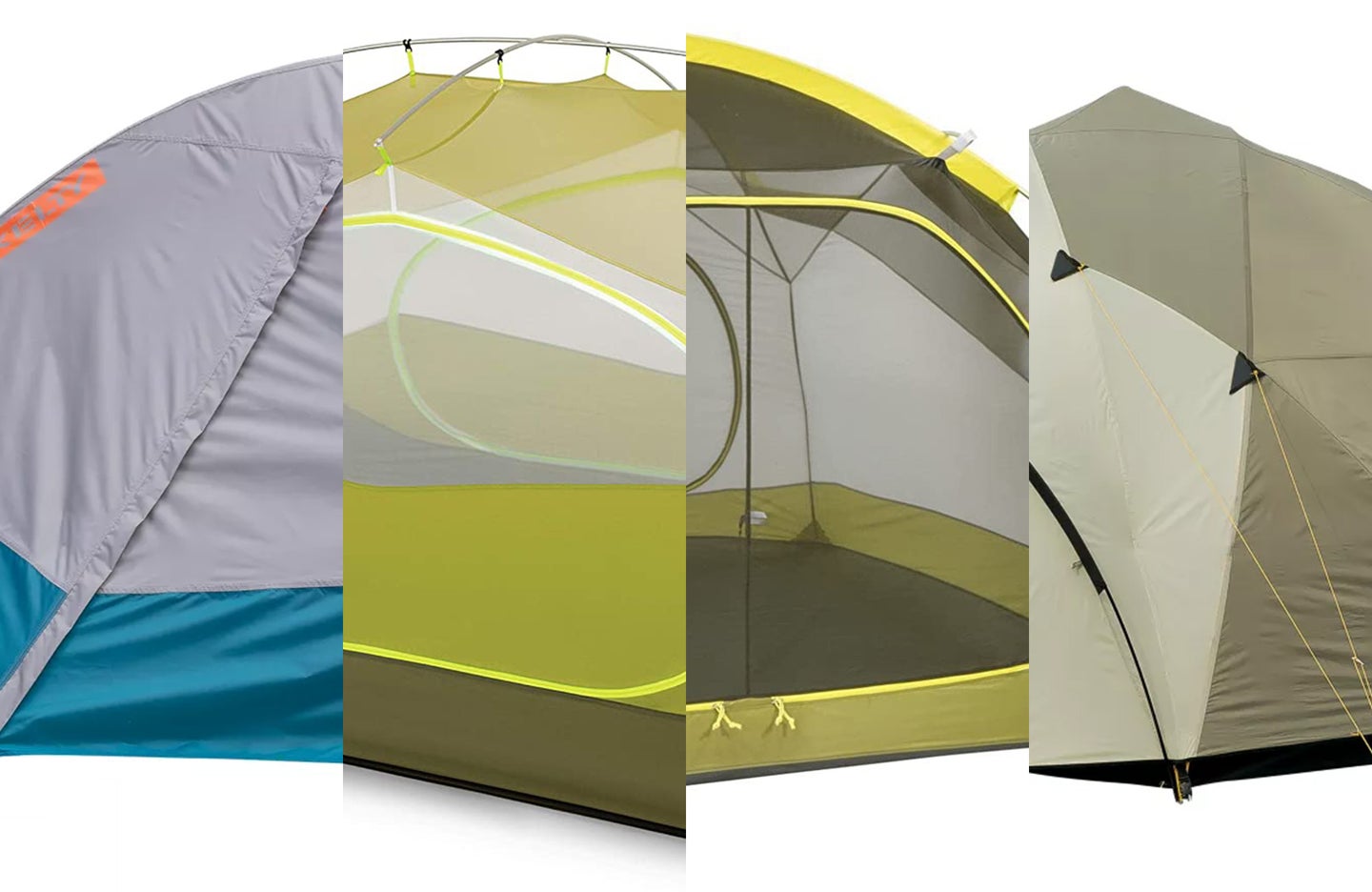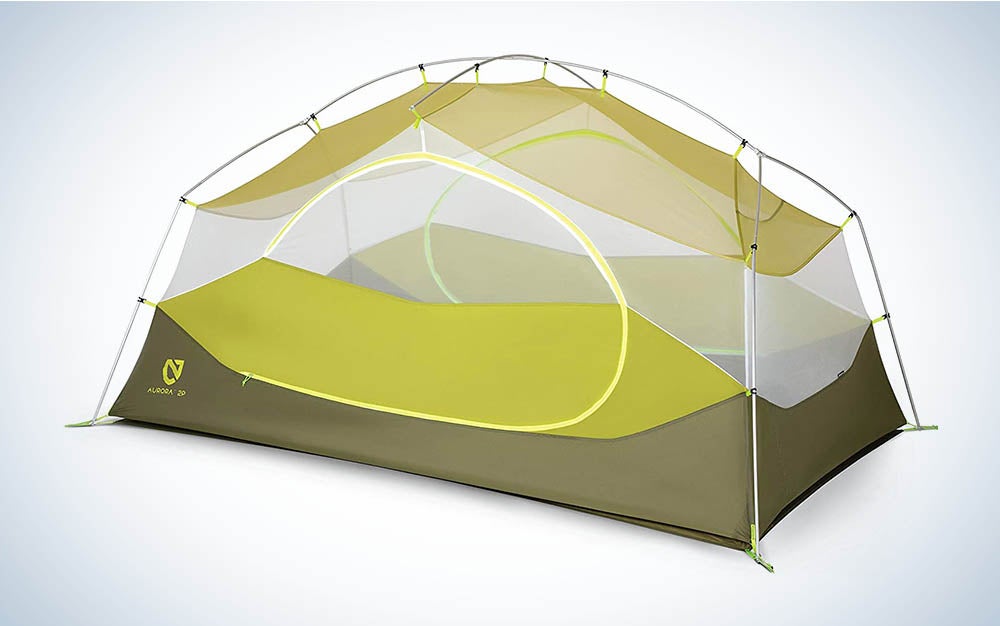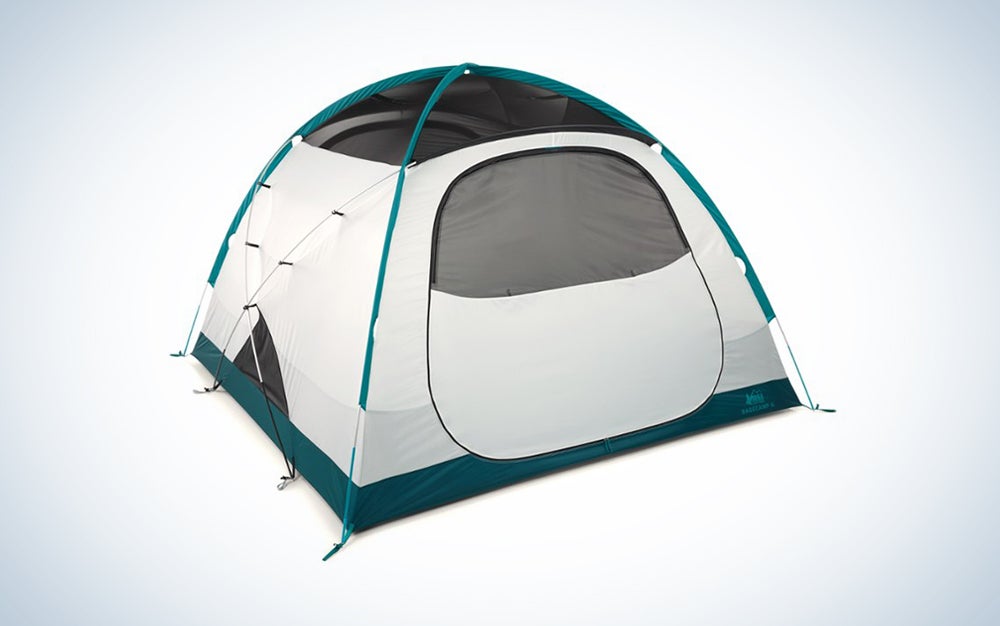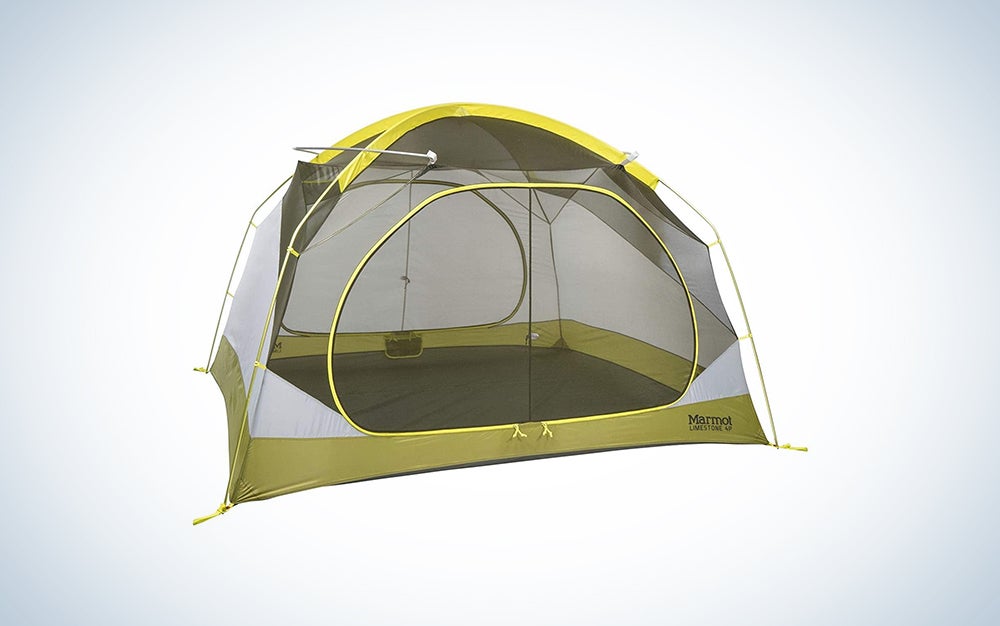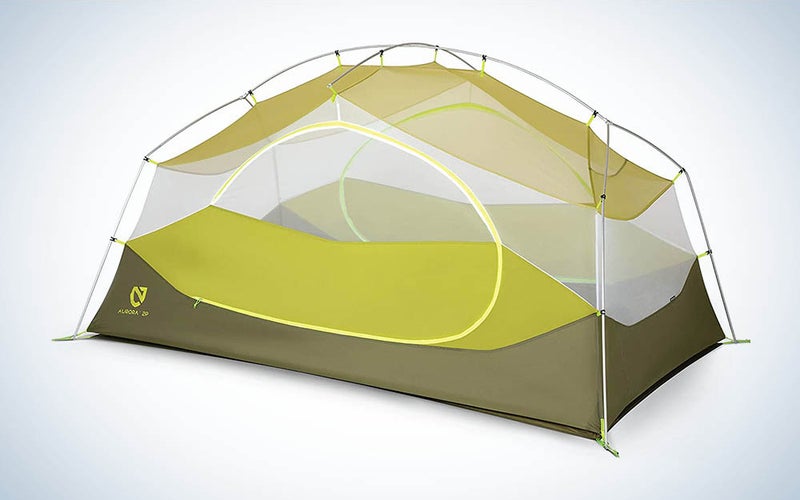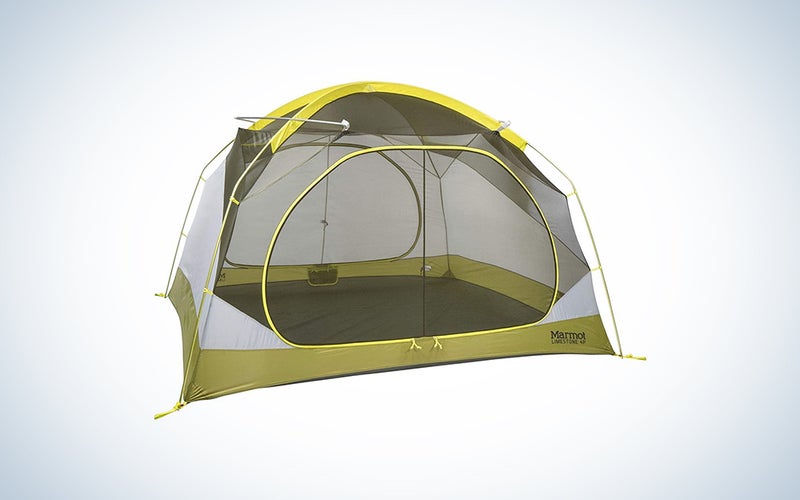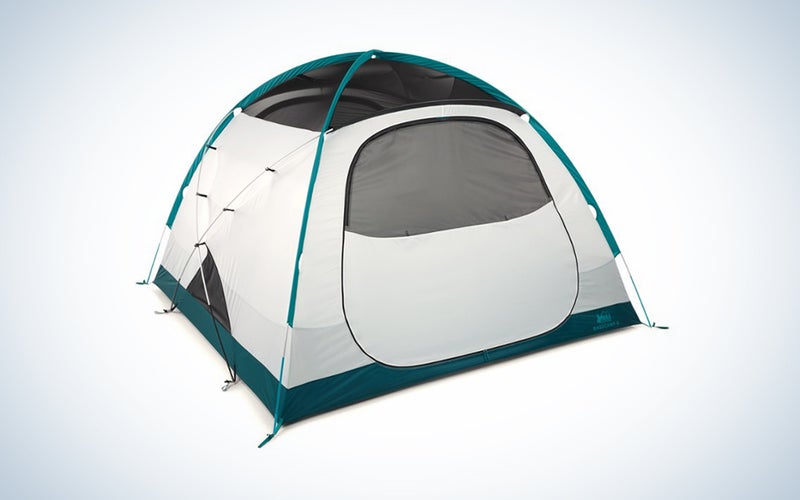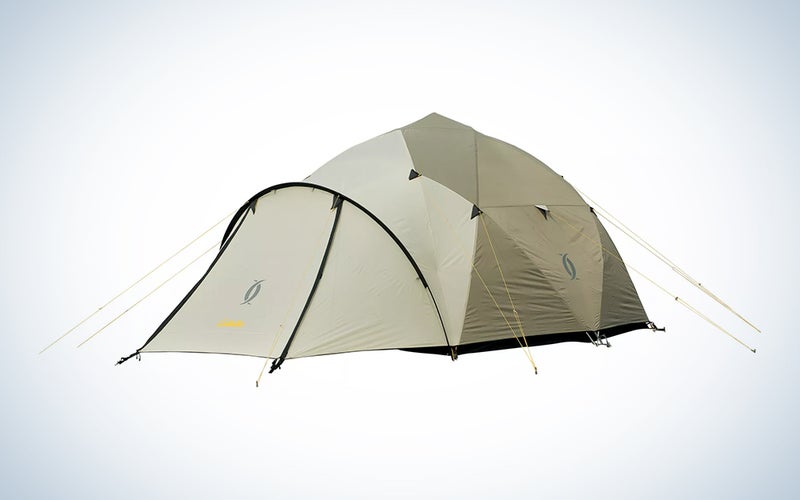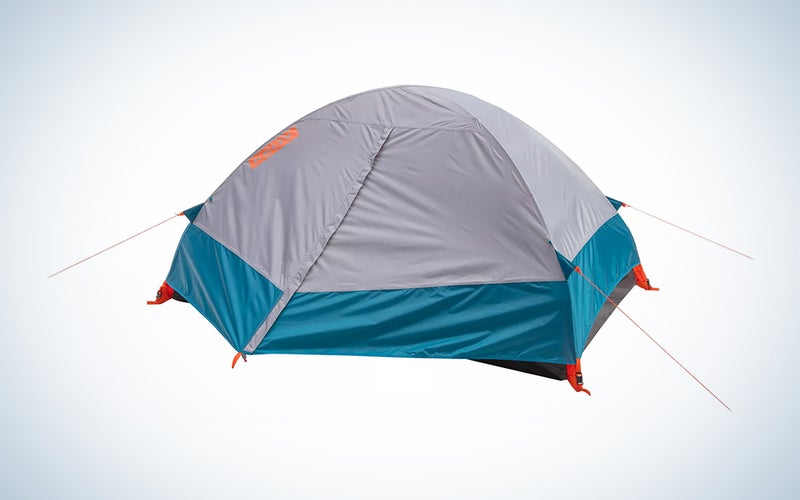We may earn revenue from the products available on this page and participate in affiliate programs. Learn more ›
When you’re spending the night outdoors, your camping tent is so much more than a shelter from rain and wind. The best camping tent is your home away from home; it’s what turns the vast wilderness into your own little haven. The right tent is also a critical part of your camping gear—a tent that rips, leaks, or requires a degree in engineering to set up will sink your trip, fast. There’s a wide variety of tents on the market, coming in all kinds of shapes, designs, weights, and materials. Here’s how to sift through them all to find the best camping tent for you.
- Best 2-person: NEMO Firefly 2 Person Backpacking Tent
- Best 4-person: Marmot Limestone 4p Tent
- Best 6-person: REI Co-op Base Camp 6 Tent
- Best for Winter: Cabela’s Instinct Alaskan Guide 6-person Tent
- Best budget: Kelty Late Start 2-Person Tent
How we chose the best camping tents
A tent has just a few jobs, but it needs to do them well: protect you from rain, wind, and bugs; stay standing; provide a place to stash your camping gear. It’s also nice if it sets up easily and packs up efficiently, and doesn’t douse you with drips from condensation or weigh a ton, either. The best camping tent will do all of those things. To narrow our search, we looked at reviews, recommendations, conducted user testing, and performed heavy research.
Best camping tents: Reviews & Recommendations
The best camping tents will keep you warm and dry from your backyard to a mountainside. Here’s what we found
Best 2-person: NEMO Firefly 2 Person Backpacking Tent
NEMO
Weighing just under 5 pounds, the NEMO Aurora still offers ample space for changing clothes or packing up gear. Two vestibules provide extra coverage for boots and backpacks, and color-coded poles make pitching it simple. This NEMO tent also has thoughtful touches, like pockets made with light-diffusing fabric and a stuff sack that makes it easy to split up the tent load between two people.
Best 4-person: Marmot Limestone 4p Tent
Amazon
With a 60-square-foot floor, the Limestone offers plenty of room for four—and its peak is 63 inches high, eliminating claustrophobia. The freestanding design is easy to set up, and large vestibule shelters camping gear. You also get several interior pockets for organizing camping equipment, including a special pocket for holding a headlamp.
Best 6-person: REI Co-op Base Camp 6 Tent
REI
A longtime favorite for group camping, the REI Co-op Base Camp 6 features easy-access double doors, strategic ventilation, two vestibules and interior pockets and hang loops for organizing everyone’s gear. The whole package weighs just under 21 pounds. Eco bonus: Solution-dyed mesh reduces the tent’s water and energy footprint.
Best for Winter: Cabela’s Instinct Alaskan Guide 6-person Tent
Cabela’s
With near-vertical walls and a peak height of 75 inches, this winter camping tent is a big step up from a snow cave. Highly durable poles, fly, and floor are built for high winds, snow, and rain. There’s also a spacious vestibule, ventilation windows, and included guy lines with tensioners so you can adjust the pitch easily as conditions change.
Best budget: Kelty Late Start 2-Person Tent
Cabela’s
The Late Start’s two aluminum poles are set up in a flash, and the mostly-mesh body allows plenty of breezes. The freestanding design includes a single door with a vestibule, and a polyester rainfly keeps you dry.
What to consider when buying the best camping tents
Different models are best suited to different locations and groups. So how do you choose the best camping tent?
First, consider how many people—or how much gear—you need to fit in the tent. Tents range in capacity from solo shelters to behemoths that can shelter six people or more. If only two people are sleeping in it, a 2-person tent might be ideal; but if those two people have a lot of camping supplies and a couple of dogs, too, they might be better off with a 3-person tent. Likewise, one family of four might find a 4-person tent to be a perfect size, while another with very young kids could be fine with a 3-person tent. These distinctions matter because the larger the tent, generally the more you’ll pay, and the heavier it will be. Weight is particularly important for backpacking tents because you’ll need to carry them into your campsite on your back. It’s less crucial for car camping tents that can be hauled in a car (but you still have to make sure they fit well in your trunk).
Also, consider the tent’s shape. If you’re tall, a shelter with a generous peak height will be more comfortable than one that’s low to the ground. Then again, a low-profile tent will be more stable in high winds, so your intended camping location and weather conditions also come into play. Durability is a related concern: Someone in the market for a winter camping tent will need the toughest materials and most stable design, while fair-weather campers can get away with lighter, less durable (and more affordable) options.
A tent’s features also matter. Need to store a bunch of backpacks, boots, and other camping gear out of the elements? You’ll want a tent with at least one vestibule. Love to keep hats, phones, and flashlights close at hand? Look for a tent with pockets. Tents with lots of mesh panels are great for hot weather and provide excellent ventilation, but they won’t keep you warm when the temperature dips. Some tents offer a freestanding design—you can pitch them without having to stake them down first—which makes them easier to set up and move around a campsite. Also, check how many doors the tent has. More doors equal easier access for everyone but will add some weight to the tent.
Are you looking for a 2-person tent?
Two-person tents are a popular choice for couples, camping friends, and solo campers who like to stretch out. They’re small enough to remain lightweight (many weigh just a few pounds) and easy to carry in a backpack, making them particularly great for backpacking excursions. And while they typically don’t provide palatial space, many designs still allow for plenty of elbow room.
When shopping for a 2-person tent, consider whether you want one door or two. A single door saves a bit of weight, but it means that the person sleeping on the other side will have to climb over the other to get in and out of the tent. Also, look at the number and size of the vestibules and make sure they cover enough space to fit all your gear and camping accessories.
Are you looking for a 4-person tent for camping?
Need shelter for the whole family? Love camping with three of your best buddies? Looking for space for your Bernese Mountain Dog, too? A 4-person tent is just the ticket. Besides providing lots more sleeping space, this size tent typically offers more headroom and elbowroom. Naturally, a 4-person tent will also weigh more than a 2-person tent, but many are still quite lightweight for the amount of interior space they provide.
When shopping, look at the number and size of doors for ease of entry and exit. A taller peak height will allow for space to play games and change squirming kids. And as with smaller shelters, a tent with lots of mesh will prevent condensation from building up on the interior and provide the best ventilation.
Do you want a 6-person tent for larger groups?
When it’s really time to party, you’ll need a 6-person tent. These ultra-large tents are perfect for groups of friends or larger families, providing expansive floor space for lining up sleeping bags and taller peaks that often allow for standing all the way up. Fairly heavy and stable, they’re ideal for setting up a basecamp for a long weekend or more.
When considering your options, look for durable materials and especially, good ventilation features to prevent condensation from so many people breathing into the same space. Also, check for an easy-to-pitch design, as tents this big can be unwieldy to set up.
Do you need a winter camping tent?
Winter camping is for the brave: Who else would voluntarily sleep outdoors when temperatures dip and snow flies? So their tents have to be hardy, too. A winter camping tent must be stable enough to handle high winds and snow loads, so look for tough materials and sturdy shapes. Vestibule space becomes even more important, as cold-weather campers and hunters have lots more bulky gear to store and need a safe shelter to cook on a camp stove.
Other winter-camp-friendly features include plentiful camping gear storage lofts and pockets inside the tent, mesh panels for ventilation, and included guy lines for increasing stability.
Are you in the market for the best camping tent on a bargain?
Some tent price tags approach the rent you’d pay to live in an actual house. And while those models tend to be premium tents with innovative designs, ultralightweight, and/or made from bombproof construction, many campers will do just fine with a more affordable choice. There are quality tents on the market that will set you back less than $200 while still performing well in the field.
Keep in mind that a bargain-priced tent will have some tradeoffs. Durability is often a big one (cheaper tents use cheaper materials and often have less-carefully designed structures). They probably won’t stand up to terrible weather, either, so consider most of them summer shelters. Bargain tents tend to weigh more, too, as ultralight materials go for premium prices. But for lower-stakes camping in campgrounds or even the backyard, why pay for a Himalayas-worthy tent?
FAQs
Q: What is the best camping tent brand?
There’s no single best camping tent brand: Plenty of brands on the market make excellent tents, and different brands make tents best suited to different types of campers. Generally, the best brands invest a lot of time and money in creating innovative new shapes, materials, and features. Their tents will be made from quality, durable materials and tested to make sure they hold up in high winds and rain. The best camping tent brands aren’t necessarily making the most expensive tents, either: Some top-shelf shelters at bargain price points perform very well. That said, some of the most respected and time-tested camping tent brands include Big Agnes, NEMO, Mountain Hardwear, REI, and Kelty.
Q: What is the best waterproof camping tent?
Similarly, there’s no one best waterproof camping tent. In fact, any tent worth buying, from bargain shelters on up to the most expensive models, should be waterproof. Most tents achieve this by including a waterproof rainfly that pitches over the tent body. All rain flies should advertise taped seams, as water can seep in through the tiny holes left by stitches on untaped seams. A tent with a rain fly is called a double-wall design; single-wall designs, in which the tent body itself is waterproof, are also available. Those are lighter to carry but less breathable, so condensation can be an issue.
Q: Are expensive tents worth it?
Generally, yes—if you need what they offer. Expensive tents cost a lot for a reason. Maybe that’s because they use ultralight-yet-strong materials, or because they’re exceptionally weatherproof. They might use a cutting-edge design that makes them more comfortable or livable. If you’re the kind of camper who’d benefit from these features—a long-distance backpacker, an ultralight hiker, or a mountaineer, for example—a pricier camping tent is well worth it. If you’re a more casual car camper, on the other hand, there’s no need to shell out for the top-of-the-line models.
Final thoughts on the best camping tents
Whether you’re planning an overnight at a local campground, a long weekend base camping with friends, or a true expedition, you’ll need the right tent. The best tent for camping will fit your intended use and weather conditions. Think about how many people (and camping gear, and even pets) need to fit inside, what season or climate you want to use it in, and your budget. Then go through the variables, such as the number and size of vestibules and doors, pockets, and accessories like guy lines, to choose the best camping tent for you.
